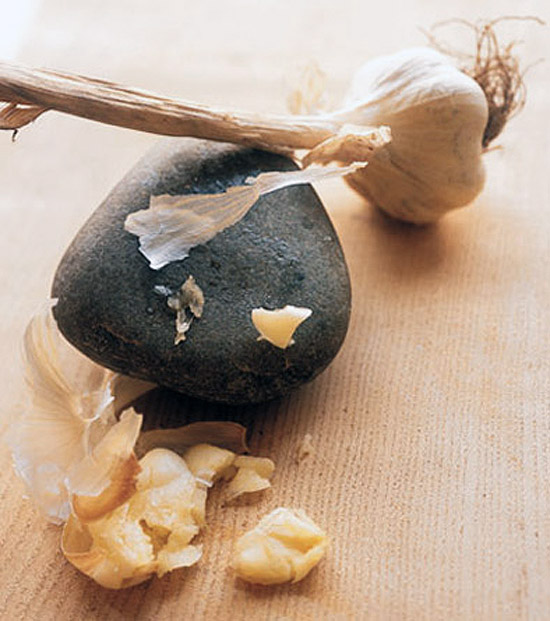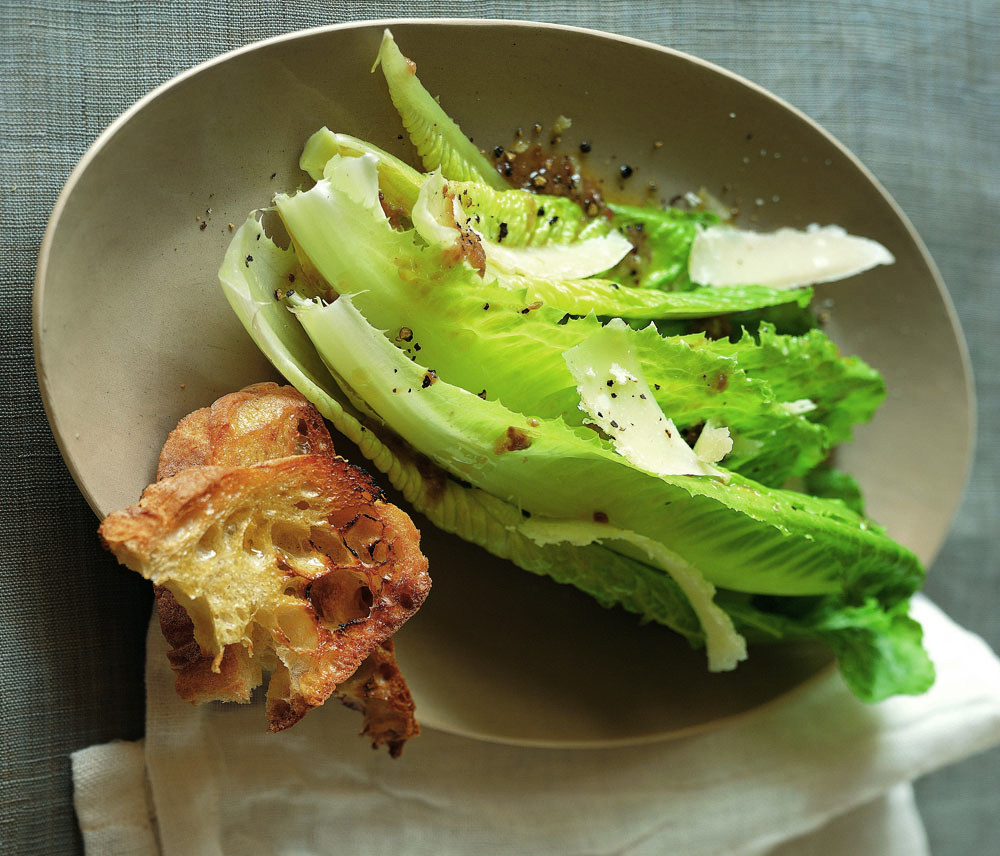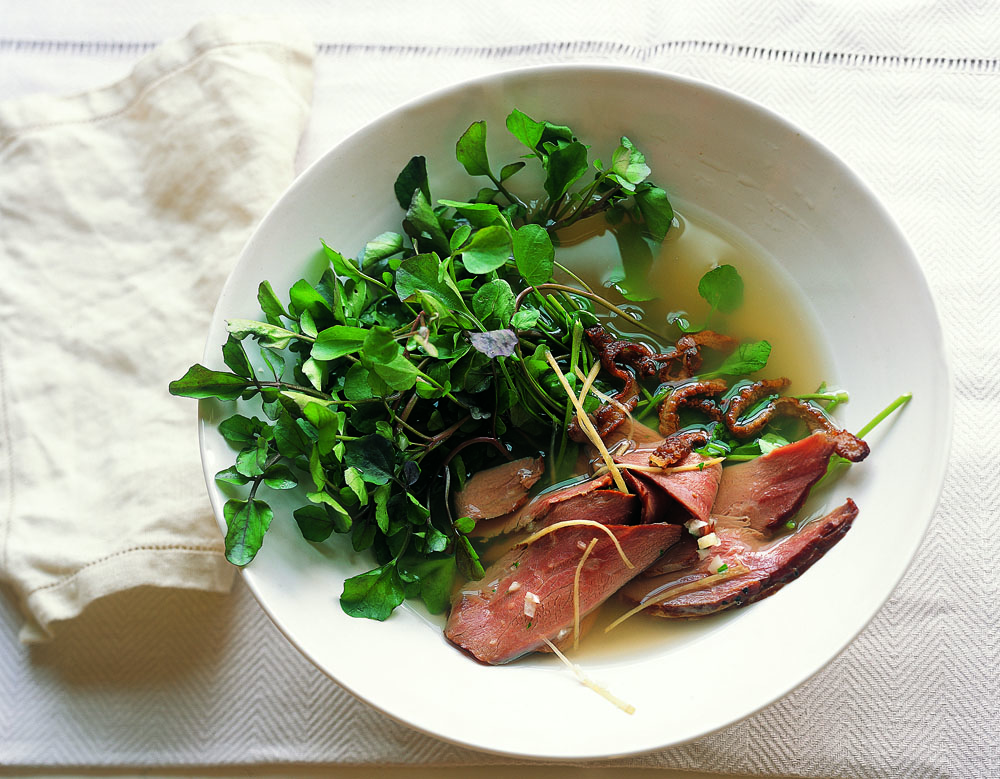Throughout the Mediterranean, the combination of garlic, anchovies* and olive oil finds its way into scores of dishes, from salads, pastas and vegetables to seafood and even lamb and veal. Here in America, it is the basis for the legendary Caesar salad. With the addition of Parmigiano, its dressing’s assertive flavors add up to something completely other than the sum of its parts – elemental, yet surprisingly mellow and satisfying (a far cry from the overly creamy, one-dimensional concoctions generally served in restaurants and salad bars.)
I consider it an essential sauce for improvising since it complements so many foods, including this lovely deconstructed Caesar Salad. The recipes for both are below, along with essential information about the oft-misunderstood anchovy.

Recipe: Essential Caesar Sauce
Since its flavors are assertive, Caesar sauce stands up particularly well to strongly flavored foods: bitter greens like dandelion, puntarelle and radicchio; cooked vegetables of all kinds from potatoes to eggplant to roasted peppers to cauliflower and broccoli; cheeses especially feta, ricotta salata and creamy sheep and goat’s milk; cold roast veal, pork and lamb; and pastas of all kinds. To sauce vegetables or pasta, warm it in a pan first until the garlic is fragrant and gently cooked.
Makes 1/3 cup, about 4 servings
1 small garlic clove, peeled
Salt
4 imported anchovies in oil, drained and patted dry*
1/4 cup extra virgin olive oil or olive-infused olive oil
2 teaspoons fresh lemon juice or to taste
1/8-1/4 teaspoon sugar
Grate the garlic on a plane grater, or place on a cutting board, sprinkle with a little salt and finely chop with a chef’s knife; use the side of the knife to mash the garlic to a paste (you should have about 1/3 teaspoon).
Place the anchovies on the garlic puree and chop and mash them with the garlic. Transfer to a small bowl.
Drizzle in the olive oil, using a pestle, the back of a large spoon or whisk to work it into the anchovy-garlic mixture; add fresh pepper to taste. If you will be using the dressing for salads, stir in the lemon juice and sugar. Store any unused dressing in a covered jar in the refrigerator, up to 2 weeks.
*A Note About Anchovy. Anchovy is the element that gives this sauce its indescribable flavor. It is neither fishy nor salty, rather, it adds an appealing pungency and punches up the flavors it comes into contact with, in the way salt does. I suspect that when people say “I don’t like anchovies”, it’s often because they have had them badly handled: either of poor quality (which can have a distinct fishiness) or used in too great a concentration or because just the notion of a tiny salted fish is off-putting. Emulsified within a well-made Caesar sauce, nobody says ever a word.
You have two possibilities when it comes to anchovies. The easiest one is to use good quality olive oil-packed anchovies. The fillets should be plump, tender and sweet tasting, not fishy. Remove the anchovies from the oil and rinse under warm water, then pat dry.
The second choice is anchovies packed in salt. They have a much brighter anchovy flavor than oil-packed anchovies so you’ll need half as many. They must be soaked to remove their salt. Rinse off the salt and soak the anchovies in several changes of warm water until they are very pliable: from a few hours to overnight (soaking also removes the salt). Rinse again to remove any scales and gently pry the fillets off the spines.
You’ll find some good basic anchovy info over at Zingerman’s. For Caesar Sauce, I recommend Ortiz Anchovy Fillets in Oil or Agostino Recca .

Recipe: Deconstructed Caesar Salad
The usual method of making Caesar salad, tossing cut-up romaine lettuce with anchovy dressing and grated Parmigiano, too often makes for a gloppy, overdressed salad. I prefer to deconstruct the parts: pristine hearts of romaine leaves lined up on a plate, drizzled with the garlicky dressing and topped with shavings of Parmigiano, with toasted garlic-rubbed bread on the side. For a pretty variation substitute whole slender treviso radicchio leaves for the romaine.
4 Servings
Discard the tough outer leaves and trim the tough ends of a 1 1/2 pound head of romaine lettuce. Slice the head lengthwise through the heart into four equal quarters, and place each quarter on a salad plate. Drizzle 2 or 3 tablespoons Essential Caesar Sauce, above, across the leaves, followed by some chopped parsley. With a vegetable peeler or plane grater, shave long, flat strips of Parmigiano-Reggiano cheese (4 to 5 ounces total) over the salad. Serve at once, with rustic bread, sliced, toasted, brushed with olive oil, rubbed with a halved garlic clove and sprinkled with salt. (I use a stove-top toaster to grill bread).






I have some Crown Prince anchovy paste the fridge – would that be terrible to use? If not, any thoughts on how much? Thank you!
Any recommendations for a good brand/source of anchovies? I’ve never used them before, so am not quite sure where to start!
You’ll find some good basic anchovy info over at Zingergman’s. For Caesar Sauce, I recommend Ortiz Anchovy Fillets in Oil or Agostino Recca .
Honestly, I have yet to find a clean-tasting anchovy paste, as hard as I’ve tried over the years. Something about them always tastes faded and metallic to me. Your best bet is to buy yourself a jar or tin of decent anchovies. For Caesar Sauce, I recommend Ortiz Anchovy Fillets in Oil or Agostino Recca .